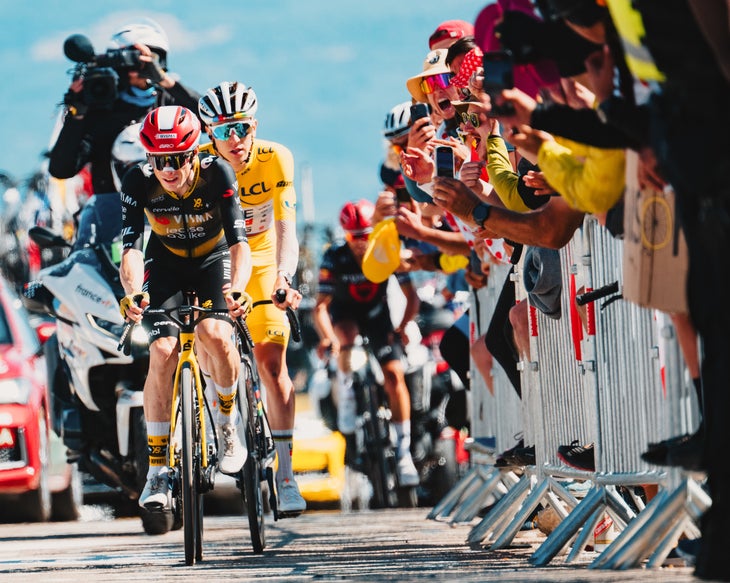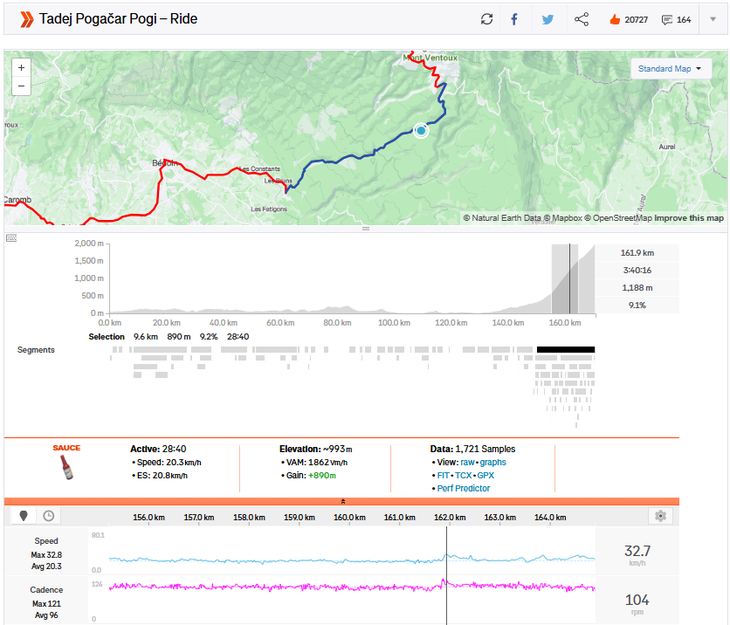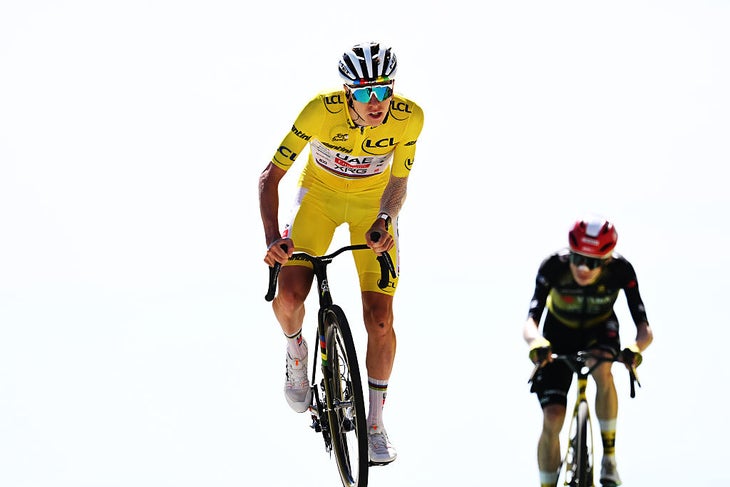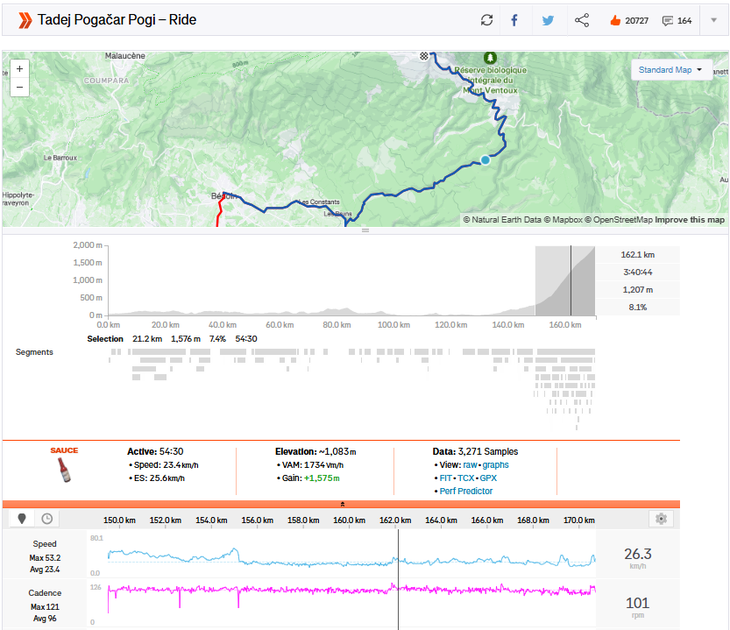“], “filter”: { “nextExceptions”: “img, blockquote, div”, “nextContainsExceptions”: “img, blockquote, a.btn, a.o-button”} }”>
I’ll be honest: when I saw the profile for Stage 16 of the Tour de France, I wasn’t very excited. Sure, the stage finished atop Mont Ventoux. But there was a long and flat run-in – 150 kilometers for the breakaway to establish a five-minute gap that Tadej Pogačar would obliterate on the final climb.
I expected the yellow jersey to destroy Jonas Vingegaard, for it to not even be close. Pogačar put more than two minutes into the Dane on Hautacam less than a week ago, which meant that the hour-long Ventoux could be even worse.
Boy was I wrong.
Vingegaard looked better than ever on the slopes of Ventoux, putting Pogačar in the hurt locker while utilizing the Visma-Lease a Bike satellite riders. As I began to analyze the numbers, I realized that this was a performance for the ages. If Vingegaard is getting better, the Tour is far from over. This is the record-setting ascent of Mont Ventoux.

Going to script — until it didn’t
When I first tuned into live coverage, it seemed like the stage was all going to script. There were only three riders in the breakaway, among them was former world champion Julian Alaphilippe. UAE Team Emirates-XRG had the break in check – so it seemed – and the stage win would go to the peloton.
But then, more attacks started coming. First it was 5, 10, 15 riders going up the road. Eventually, more than 30 riders made it into the breakaway of the day, including Ben Healy, Valentin Paret-Peintre, Santiago Buitrago, and Enric Mas. Crucially, two of Pogačar’s teammates made it into the break (Pavel Sivakov and Marc Soler), as well as two of Vingegaard’s teammates (Tiesj Benoot and Victor Campenaerts). We’ll come back to those names later.
Nils Politt tried to control the gap, but the breakaway was soon more than five minutes ahead of the peloton. Even then, they continued attacking until a second breakaway formed, gaining a one-minute advantage by the base of Ventoux.
Now this is where it all begins: the mythical climb of Mont Ventoux. This isn’t just an ordinary climb; this is one of the longest and most difficult climbs in cycling. It will take the fastest riders in the world nearly an hour to complete it. A strong amateur could manage the climb in around two hours. If you’re not an avid cyclist, you might not be able to finish the climb at all.
After a modest start, the middle part of Mont Ventoux is the steepest. From Saint-Estève to Chalet Reynard, there is an average gradient of 9.4% for 9km. This section of the climb snakes its way through a forest, which means that it is largely protected from the wind. But at the Chalet Reynard, the road turns to the Northwest towards the summit. Now, the trees have disappeared, and the landscape is made of bare limestone, which almost makes the mountain look like a sand dune.
The wide open landscape is completely exposed to the wind; and during stage 16, there was a significant headwind for these final 7km of climbing. In the final part of the climb, the gradients are more forgiving until the 10% wall just before the finish. A hairpin corner with 100m to go can cause gaps in a sprint finish, if there is even a sprint at all.
With a headwind for the final 7km, would the riders be more passive in their approach to Mont Ventoux.
No. They would take the climbing record by nearly a minute.
Visma set out stomping in the first few kilometers of Mont Ventoux. One-by-one, their riders peeled off after a job well done. Sepp Kuss came to the front, and that’s when the real damage started being done. The American’s pace was so hard that he dropped his own teammate, Simon Yates, off his wheel. So it was only Kuss and Vingegaard left from Visma, and only Pogačar left from Team UAE.
Kuss was pacing at 6.2-6.3w/kg during this section of the climb, a ridiculous rate considering there was still 14km of climbing to go. After 20 minutes of ripping the pedals apart, Kuss swung off and Vingegaard attacked. It was one of the biggest attacks we’ve seen this Tour, putting Pogačar under pressure and dropping everyone else out of frame. Vingegaard hit 33kph on this 9.5% section of the climb, with Pogačar grimacing in his wheel.
You can see the exact moment that Vingegaard attacked in Pogačar’s Strava file. After spiking his speed and cadence, Pogačar settled into Vingegaard’s pace of more than 7w/kg. The pace was lifted even further when Vingegaard caught his teammate, Tiesj Benoot. The Belgian pulled hard as they turned left into the headwind.

Pogačar – Saint-Estève to Chalet Reynard
- Time: 28:40
- Estimated Average Power: ~420w (~6.6w/kg)
- VAM: 1,862 Vm/h
- Vauquelin: 30:44 at 404w (5.9w/kg)
- Vingegaard’s Attack: 8 minutes at 1,926 Vm/h (~7.2w/kg)
Once Benoot emptied his tank, Vingegaard attacked again, but Pogačar was straight onto his wheel. The Dane continued pulling, and it looked like Pogačar was suffering. But now that they’d entered the final section of the climb, Pogačar could take respite in Vingegaard’s draft in the headwind.
Vingegaard had one more teammate up the road in the shape of Victor Campenaerts. The Belgian is in the climbing form of his life, and he showed it again by pulling first and second in GC up Mont Ventoux. It was rinse and repeat when Campenaerts pulled off, and Vingegaard attacked with Pogačar on his wheel. But this time, the yellow jersey was prepared to counter, and Pogačar attacked while the breakaway was only a minute up the road.
This time, Vingegaard was on a gap. It took a few moments for the Dane to close it, but as soon as Vingegaard was back on Pogačar’s wheel, the pair slowed for the final time. There was only a moment to catch our collective breaths before Vingegaard attacked again, but even this one couldn’t shake Pogačar.
A few hundred meters up the road, Ben Healy opened up the final sprint in the breakaway. The Irishman led into the final hairpin, but it was Valentin Paret-Peintre who came around him to take the stage win, the first win for a French rider in this year’s Tour.
After pulling for the vast majority of the climb, Vingegaard didn’t have the strength left to overhaul Pogačar in the sprint. The yellow jersey took a few more seconds in GC and fifth place on the stage, while Vingegaard might actually feel better about this sixth place than when he was second on Hautacam.
Now let’s take a closer look at these record-setting numbers.

The power numbers behind the performance
The fastest-ever ascent of Mont Ventoux (until today) was Iban Mayo who set a time of 55 minutes and 38 seconds. That was an individual time trial stage in the 2004 Critérium du Dauphiné, so the climbing times were faster than ever. The riders were fresh at the bottom of the climb, they paced themselves to go as fast as possible (time trial), and it was also 2004.
In 2025, the peloton arrived at the base of Mont Ventoux after 150km of racing, and it was already stage 16 of the Tour. There was a headwind on the final third of Ventoux, and there were plenty of stop-start tactics that could have lowered the average speeds.
Nevertheless, Pogačar and Vingegaard destroyed Mayo’s record on Ventoux by more than a minute. The new Mont Ventoux record is 54 minutes and 30 seconds set by Pogačar, with Vingegaard being only two seconds slower. But when we’re comparing their performances, Vingegaard actually did a higher w/kg on the climb. The Dane attacked multiple times and pulled nearly the entire headwind section, while Pogačar only attacked once and hardly touched the wind.
Simply put, this is the best 50+ minute climbing effort in cycling history. Both Vingegaard and Pogačar did nearly 6.5w/kg for an hour, and that included multiple attacks and finessing into a headwind.

Pogačar – Mont Ventoux
- Time: 54:30
- Estimated Average Power: ~410w (~6.4w/kg)
- VAM: 1,734 Vm/h
- Vingegaard: 54:32 (~6.5w/kg)
- Vauquelin: 57:30 at 395w (5.8w/kg)
What does this mean for the rest of the Tour? Well, it certainly isn’t over. If there is one thing that will make Pogačar crack, it is long and hard mountain stages in the third week of the Tour. Vingegaard has cracked the Slovenian on Col de la Loze before, and in two days’ time, he will try to do it again.
Stage 18 of this year’s Tour includes 5,642 meters of climbing in just 172km. The high-altitude finish at Courchevel could be Vingegaard’s opportunity to flip the script. No matter what happens, we know that Vingegaard will try. His team will go all-in for him like they did on Mont Ventoux, and Pogačar knows that a crack on Col de la Loze can quickly turn into a fissure.
Power Analysis data courtesy of Strava
Strava sauce extension
Riders:
Source link
